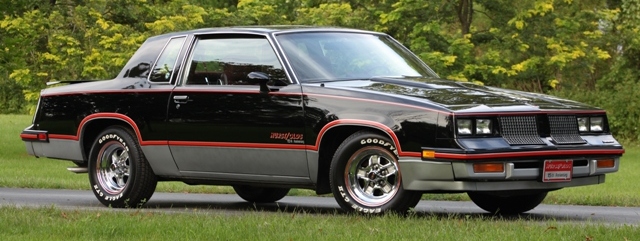 The Right Car at the Right Time — Even if it wasn’t a True Muscle Car
The Right Car at the Right Time — Even if it wasn’t a True Muscle Car
With our previous post about the new Hurst HEMI Hauler truck, we thought a retrospective look at a car the company did nearly 30 years ago would be appropriate – the 1983 Cutlass-based Hurst/Olds. The mid-Eighties were strange times for performance car fans. The glory days of the muscle car era were only about 15 years earlier, but when they ended, an entirely new mentality overtook the public consciousness. A little more than a decade later, the good old days might well have been ancient history, as cars changed profoundly and fundamentally.
Front-wheel drive, fuel injection and ads that touted miles per gallon rather than miles per hour were the norm in the 1980s. The few models that had performance intents were next-generation cars with McPherson strut suspensions, turbochargers and dashboards that looked like circuit boards. Then there was the 1983 Hurst Olds.
Only 3,001 examples were built (201 sold in Canada), all of them black with a silver lower body and red dividing stripe. Special badges, door graphics, a rear spoiler and styled steel wheels were part of the striking exterior package. All of the cars came off Olds’ assembly line in Lansing, Mich., and then shipped about 45 miles away to secondary manufacturer Cars and Concepts, which changed each Cutlass into a Hurst model. Each carried the order code W-40. T-Tops were an $825 option and a power moon roof was offered, too.
Performance-wise, every Hurst Olds packed at four-barrel-fed, 180-horsepower 307-cubic-inch engine, a Hydra-Matic 200-4R overdrive transmission and a 3.73 rear axle. Along with its 180 horses was a solid 245 lb.-ft. of torque. It was a combination good for 16-second quarter-miles and 0-60 sprints of about 9 seconds.
The performance may not have set the drag strip on fire, but the Hurst Lightning Rod shifter system gave the car a unique, signature feature that looked wild and worked quite well. Essentially a mechanical version of the electronically controlled manual-shift automatics used in many cars today, the Lightning Rod shifter enabled the driver to use a separate shifter for each up-shift.
After a successful run in 1983, the Hurst Olds returned in 1984 with a silver-over-black paint scheme that was essentially a reversal of the first-year model. The only real product difference was the changed to a larger, 8.5-inch rear axle. Production increased to 3,500 units.From a desirability standpoint, the slightly lower production and more striking paint scheme gives the 1983 models the nod. The silver ’84 cars have all the goods and look strong, but it’s hard to beat the all-business aesthetic of the black 1983 cars. They just look like special-edition performance cars.
Michigan resident Ken Arbic owns the example seen in our photos.

